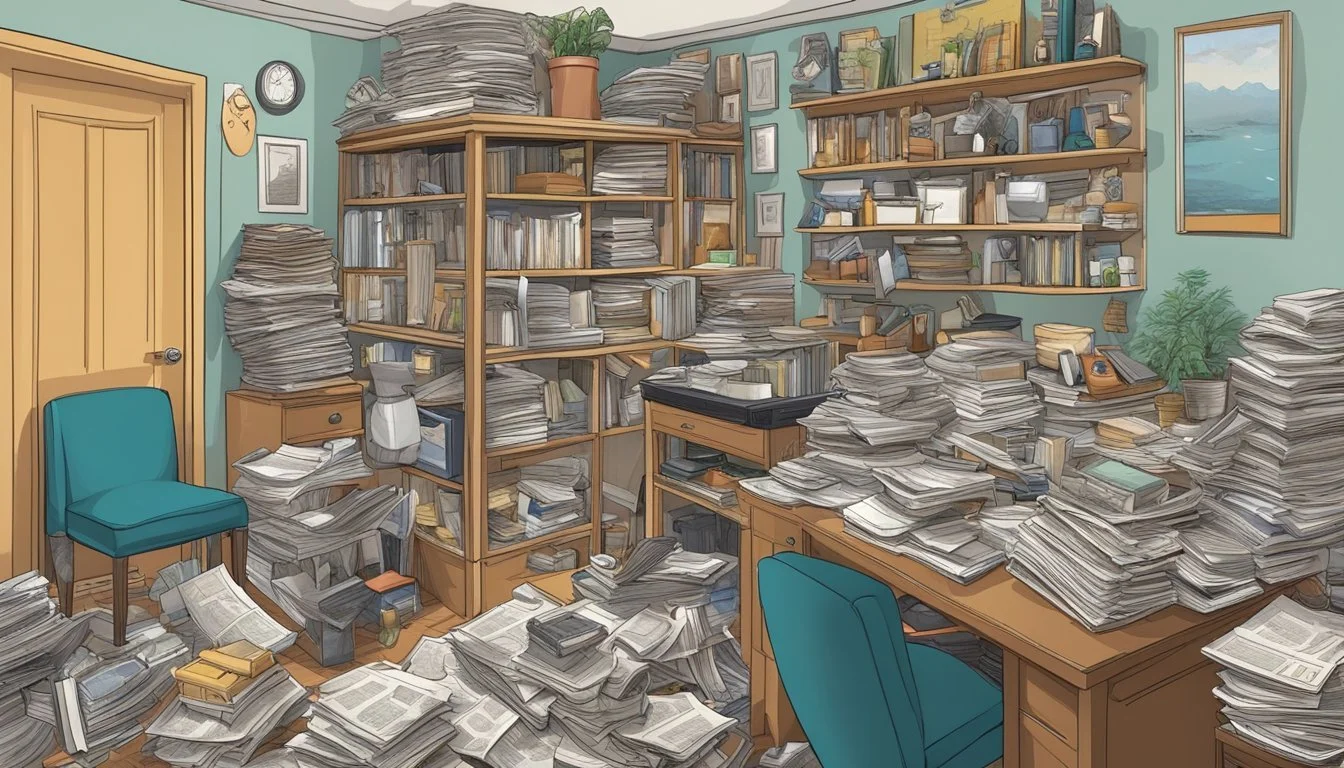Understanding the Initial Stage of Compulsive Accumulation
Hoarding disorder is a complex mental health condition recognized by the American Psychiatric Association. It involves difficulty discarding or parting with possessions, regardless of their actual value. Level 1 hoarding represents the mildest form of this disorder.
At level 1, individuals may exhibit mild clutter in their living spaces, but it does not significantly impair their daily functioning or safety. The accumulation of items is noticeable but not overwhelming. People at this stage often maintain relatively clean and organized homes, though they may struggle with decision-making about what to keep or discard.
Early intervention and treatment can be highly effective for those experiencing level 1 hoarding behaviors. Mental health professionals can help individuals develop strategies to manage their acquiring and discarding habits, addressing the underlying emotional attachments to possessions. Cognitive-behavioral therapy and organizational skills training are common approaches used to prevent the progression of hoarding symptoms to more severe levels.
Understanding Hoarding Disorder
Hoarding disorder is a complex mental health condition characterized by persistent difficulty discarding possessions. It involves excessive accumulation of items and severe distress at the thought of parting with them.
Definition and Classification
Hoarding disorder is recognized as a distinct diagnosis in the DSM-5. It involves the accumulation of a large number of possessions that congest living areas, significantly compromising their use. People with hoarding disorder experience intense urges to save items and extreme anxiety when faced with discarding them.
The disorder is classified as a related condition to obsessive-compulsive disorder. It can range in severity from mild to extreme cases that pose serious health and safety risks.
Signs and Symptoms
Key symptoms of hoarding disorder include:
Difficulty discarding or parting with possessions
Strong urges to save items, regardless of actual value
Excessive acquisition of new things
Cluttered living spaces that impede normal use
Significant distress or impairment in daily functioning
People with hoarding disorder may also experience indecisiveness, perfectionism, avoidance, and problems with attention and organization. The accumulation of items often leads to unsanitary conditions, fire hazards, and social isolation.
Hoarding vs. Collecting
While hoarding and collecting may appear similar, they are distinct behaviors. Collectors typically:
Acquire items deliberately and systematically
Organize and display their collections with pride
Find enjoyment in their collections
Hoarders, in contrast:
Acquire items compulsively and indiscriminately
Experience clutter that interferes with living spaces
Feel distress about their accumulation
Collecting is usually a pleasurable hobby, while hoarding causes significant distress and impairment in daily life. The key difference lies in the level of organization, the impact on living spaces, and the emotional attachment to possessions.
Risk Factors and Causes
Hoarding disorder stems from a complex interplay of genetic, neurological, psychological, and environmental factors. Research has identified several potential contributors that increase susceptibility to this condition.
Genetic and Brain Function
Studies suggest a genetic component to hoarding disorder. Individuals with a family history of hoarding are more likely to develop the condition. Brain imaging research has revealed differences in neural activity and structure in people with hoarding tendencies.
Certain areas of the brain involved in decision-making, attachment, and emotional regulation show altered functioning. This may contribute to difficulty discarding items and excessive acquisition behaviors.
Psychological and Emotional Factors
Anxiety and depression frequently co-occur with hoarding disorder. These conditions can intensify hoarding symptoms and make treatment more challenging.
Obsessive-compulsive disorder (OCD) shares some overlapping features with hoarding. However, hoarding is now recognized as a distinct disorder.
People who hoard often form strong emotional attachments to possessions. Objects may provide a sense of security or serve as memory aids.
Perfectionism and indecisiveness are common traits. Fear of making mistakes can lead to keeping items "just in case" they're needed later.
Life Experiences and Trauma
Stressful or traumatic life events can trigger or exacerbate hoarding behaviors. The loss of a loved one, divorce, or other significant changes may prompt increased acquisition and difficulty letting go of possessions.
Childhood experiences like material deprivation or forced discarding of belongings can influence later hoarding tendencies. Growing up in a chaotic or disorganized environment may also play a role.
Age is a factor, with symptoms typically emerging in adolescence or early adulthood. Hoarding often worsens over time, becoming more severe in older adults.
Consequences of Hoarding
Hoarding disorder can have severe impacts on various aspects of a person's life. It affects living spaces, poses safety risks, and strains relationships with family and friends.
Impact on Living Spaces
Hoarding significantly alters living conditions. Rooms become cluttered and difficult to navigate. Piles of items cover floors, furniture, and surfaces. This accumulation makes it challenging to use spaces for their intended purposes.
Kitchens and bathrooms may become unusable due to excessive clutter. Appliances might be inaccessible or non-functional. Beds can be buried under possessions, forcing individuals to sleep in chairs or on the floor.
Unsanitary conditions often develop. Dust accumulates on rarely moved items. Food waste attracts pests. Mold and mildew grow in damp, crowded areas. These factors create health hazards for occupants.
Fire Hazard and Safety Concerns
Hoarding significantly increases fire risks. Piles of flammable materials provide fuel for fires to spread rapidly. Blocked exits make escape difficult in emergencies.
Firefighters face challenges navigating cluttered spaces. This delays rescue efforts and puts both residents and first responders at risk. Excessive weight from hoarded items can weaken floors, posing structural dangers.
Blocked windows prevent proper ventilation. This can lead to air quality issues and potential carbon monoxide buildup. Tripping hazards are common, increasing the risk of falls and injuries.
Effect on Relationships and Social Life
Hoarding often strains relationships with family members and friends. Loved ones may feel frustrated or helpless when attempts to help are rebuffed. Arguments about clutter and its impact on shared living spaces are common.
Social isolation frequently occurs. Individuals may feel embarrassed about their living conditions and avoid inviting others over. This leads to a withdrawal from social activities and gatherings.
Quality of life suffers as hoarding consumes time and energy. Work performance may decline. Hobbies and interests are neglected. The focus on acquiring and maintaining possessions can overshadow other aspects of life, leading to a narrowed existence.
Assessment and Diagnosis
Accurate assessment and diagnosis of hoarding disorder are crucial for effective treatment. Mental health professionals use specific criteria and tools to differentiate hoarding from other conditions and determine its severity.
Diagnostic Criteria
The American Psychiatric Association's Diagnostic and Statistical Manual of Mental Disorders (DSM-5) outlines key criteria for hoarding disorder. These include persistent difficulty discarding possessions, regardless of their actual value. The accumulation of items clutters living spaces, making them unusable.
Individuals experience significant distress or impairment in daily functioning due to hoarding behaviors. The symptoms must not be better explained by another medical condition or mental disorder.
Assessment Tools and Scales
Mental health professionals use various assessment tools to evaluate hoarding severity. The Saving Inventory-Revised (SIR) is a 23-item questionnaire that measures excessive acquisition, difficulty discarding, and clutter.
Other useful scales include the Clutter Image Rating and the Hoarding Rating Scale. These tools help clinicians assess the extent of clutter and its impact on living spaces.
Comprehensive assessments often involve home visits to directly observe living conditions and the level of accumulation.
Differentiating from Other Mental Disorders
Distinguishing hoarding disorder from other conditions is essential for proper treatment. Obsessive-compulsive disorder (OCD) may involve hoarding symptoms, but the underlying motivations differ.
In hoarding disorder, individuals often feel emotionally attached to possessions. In contrast, OCD-related hoarding is typically driven by specific fears or obsessions.
Depression can sometimes lead to clutter accumulation, but this is usually temporary and resolves with treatment of the mood disorder.
Careful assessment helps clinicians differentiate hoarding from similar-appearing conditions, ensuring appropriate interventions are recommended.
Treatment and Management
Effective approaches for hoarding disorder combine therapeutic interventions, medication when needed, and practical support. These strategies aim to address underlying issues, modify behaviors, and create sustainable changes in living environments.
Cognitive Behavioral Therapy
Cognitive Behavioral Therapy (CBT) is the primary treatment for hoarding disorder. It helps individuals identify and change problematic thoughts and behaviors related to acquiring and discarding possessions.
CBT for hoarding typically involves:
Challenging beliefs about the need to save items
Practicing decision-making skills for sorting and discarding
Exposure exercises to reduce anxiety about letting go of possessions
Developing organizational strategies
Therapists may conduct home visits to assess clutter and guide hands-on decluttering efforts. CBT sessions often occur weekly and can last several months, with ongoing support as needed.
Medication and Pharmacotherapy
While no medications specifically treat hoarding disorder, some may help manage associated symptoms or co-occurring conditions. Selective serotonin reuptake inhibitors (SSRIs) are sometimes prescribed to address anxiety or depression that often accompany hoarding behaviors.
Common SSRIs used include:
Fluoxetine
Paroxetine
Sertraline
These medications can help reduce emotional distress and may make it easier for individuals to engage in therapy and decluttering efforts. Doctors carefully monitor medication effects and adjust dosages as needed.
Professional Organizing and Support Services
Professional organizers specializing in hoarding disorder can provide crucial assistance. They work alongside individuals to:
Develop personalized organizing systems
Create action plans for decluttering
Teach sorting and decision-making skills
Assist with the physical process of removing items
These professionals often collaborate with therapists to reinforce treatment goals. They may also help coordinate cleanouts and connect clients with resources for item removal or donation.
Support Groups and Community Resources
Support groups offer valuable peer connections and shared experiences for individuals with hoarding disorder. These groups provide:
A safe space to discuss challenges and progress
Opportunities to learn from others' coping strategies
Motivation and accountability for decluttering goals
Local mental health organizations or hoarding task forces may offer support groups. Online forums and virtual meetings are also available, providing accessible options for ongoing support.
Community resources can include:
Hoarding clean-up services
Legal aid for housing issues
Social services for additional support
These resources help address practical concerns and create a network of support for long-term management of hoarding behaviors.
Hoarding Disorder in Special Populations
Hoarding disorder can manifest differently across various populations. The condition affects animals, adolescents, and individuals with co-occurring mental health conditions in unique ways.
Animal Hoarding
Animal hoarding involves accumulating a large number of animals without providing adequate care. This form of hoarding often results in unsanitary living conditions for both humans and animals.
Animal hoarders typically struggle to recognize the negative impact of their behavior. They may believe they are rescuing or protecting the animals.
Veterinary care is often neglected in animal hoarding cases. This can lead to untreated illnesses and injuries among the hoarded animals.
Intervention in animal hoarding cases requires a multi-disciplinary approach. This often involves animal welfare organizations, mental health professionals, and law enforcement.
Hoarding in Adolescents
Hoarding behaviors can emerge during adolescence. Early identification and intervention are crucial for preventing the disorder from progressing into adulthood.
Adolescent hoarders may face unique challenges, such as conflicts with family members over clutter in shared living spaces.
School performance can be impacted by hoarding behaviors. Adolescents might struggle to complete homework or find necessary school supplies in cluttered environments.
Treatment approaches for adolescent hoarders often involve family therapy. This helps address family dynamics that may contribute to or exacerbate hoarding behaviors.
Hoarding and Co-occurring Conditions
Hoarding disorder frequently co-occurs with other mental health conditions. This can complicate diagnosis and treatment.
Anxiety and depression are common among individuals with hoarding disorder. These conditions may contribute to the urge to acquire and difficulty discarding items.
ADHD is also prevalent in hoarding populations. The impulsivity associated with ADHD can lead to excessive acquisition of items.
Obsessive-compulsive disorder (OCD) shares some similarities with hoarding. However, hoarding disorder is now recognized as a distinct condition in diagnostic manuals.
Treatment plans for individuals with co-occurring conditions often involve addressing multiple disorders simultaneously. This integrated approach can lead to better outcomes.
Prevention and Planning
Effective strategies for preventing hoarding disorder and planning interventions are crucial for individuals, families, and communities. Early recognition, education, and support can significantly reduce the impact of this condition.
Building Awareness and Education
Public awareness campaigns play a vital role in prevention efforts. These initiatives help identify early signs of hoarding behavior and promote understanding of the disorder. Educational programs in schools and community centers can teach coping skills and healthy habits.
Mental health professionals offer workshops on decluttering techniques and organizational strategies. These sessions provide practical tools for managing possessions effectively.
Online resources and support groups connect individuals with similar experiences. This network fosters a sense of community and reduces feelings of isolation often associated with hoarding.
Community Involvement and Policy
Local governments can implement policies to address hoarding-related health and safety concerns. Building inspectors and fire departments may conduct regular checks to ensure compliance with safety codes.
Collaborative efforts between mental health services, social workers, and housing authorities help create comprehensive support systems. These partnerships can prevent evictions and provide assistance to those at risk.
Community clean-up events encourage neighbors to work together, fostering a supportive environment. Such initiatives can help identify individuals who might benefit from early intervention.
Preparing for Emergencies
Developing emergency plans for individuals with hoarding tendencies is crucial. This includes creating clear pathways and ensuring access to exits in case of fire or medical emergencies.
Family members and caregivers should be trained in crisis management techniques. They need to know how to respond effectively during sudden health issues or safety concerns.
Establishing a network of trusted professionals, including therapists, organizers, and cleaners, can provide quick support when needed. This team can assist in maintaining a safe living environment and preventing potential crises.






